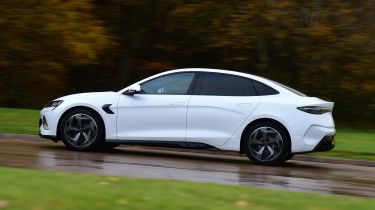BYD Seal - Range, charging & running costs
The BYD Seal has decent residuals, but slow charging speeds, low real-world efficiency, and high insurance costs are disappointing
|
Model |
Battery size |
Range |
Insurance group |
|
Seal Design |
82.5kWh (useable) |
354 miles |
48D |
|
Seal Excellence AWD |
82.5kWh (useable) |
323 miles |
50D |
Electric range, battery life and charge time
The base rear-drive BYD Seal has a maximum claimed range of 354 miles, while the four-wheel drive version has a nearly-nine per cent drop to 323 miles. That’s due to the inefficiencies of having an additional electric motor driving the front wheels and a weight penalty of around 130kg compared with its sibling. Both versions use a 82.5kWh capacity battery.
We haven’t had a chance to range test a rear-wheel drive Seal yet, but the four-wheel drive version proved to be the least efficient EV during our company car group test with only 3.0mi/kWh. That’s a shame, because it has a larger battery than the equivalent dual-motor Tesla Model 3, yet the latter managed 3.8mi/kWh, allowing it to go significantly further on a charge. We expect the lighter rear-wheel drive Seal to have a much better range.
A peak charge rate of 150kW is slightly down on all the main competitors, especially against the Hyundai Ioniq 6, which can handle up to 233kW. This means the Seal has a relatively slow 10-80 per cent (from roughly 35 miles remaining up to 280 miles) charging time from a suitable rapid charger of nearly 40 minutes, whereas the Ioniq 6 takes under 20 minutes. The Ioniq 6 has a smaller battery pack (74kWh useable), which will take less time to charge than the Seal (82.5kWh usable), but that’s a significant amount of additional time to wait before you can set off again.
More reviews
Most owners will probably charge the Seal overnight at home via a 7kW wallbox. In the worst-case scenario of refilling a completely flat battery, which few owners will ever do, it will take a little over 13 hours.
The battery is guaranteed to retain 70 percent capacity for eight years or 125,000 miles, which is longer than the warranties on BMW and Tesla battery packs.
Tax
The Seal will make sense to company car drivers because of the low Benefit-in-Kind (BiK) tax band electric cars sit in, at least until 2025. It’ll also be exempt from road tax, and the London Congestion Charge costs until 2025, too.
Insurance groups
Unfortunately, insurance is likely to be costly. The entry-level Design model is in group 48, which is considerably higher than the Hyundai Ioniq 6 in group 36, and the BMW i4 and Volkswagen ID.7, which both start in group 38.
The top-of-the-range Excellence AWD is in the highest group 50 ranking, which is higher than the most potent M50 version of i4, and is also above that of the even faster Kia EV6 GT, which is in group 45.
Depreciation
Residual values for the Seal are likely to be in between its main rivals. Our expert data suggests that after three years and 36,000 miles, the Seal will maintain around 53 per cent of its resale value, putting it above the Ioniq 6, which ranges from 48 per cent for the Ultimate AWD model up to 53 per cent for the Premium RWD, and slap-bang in the middle of the BMW i4 between the 50 per cent for the M50 and 55 per cent for the eDrive35 Sport. The Seal can’t quite reach the heights of the Tesla Model 3, which is likely to be worth up to 56 per cent in standard rear-wheel drive form – and that version is cheaper than the Seal.




